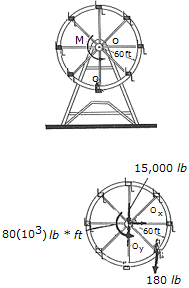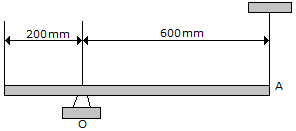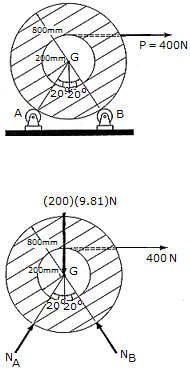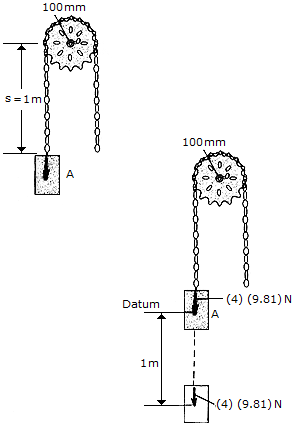Engineering Mechanics - PKRB: Work and Energy
- PKRB: Work and Energy - General Questions

A man having a weight of 180 lb sits in a chair of the Ferris wheel, which has a weight of 15,000 lb and a radius of gyration of ko = 37 ft. If a torque of M = 80(103) lb • ft is applied about O, determine the angular velocity of the wheel after it has rotated 180°. Neglect the weight of the chairs and note that the man remains in an upright position as the wheel rotates. The wheel starts from rest in the position shown.

The uniform slender rod has a mass of 5 kg. Determine the magnitude of the reaction at the pin O when the cord at A is cut and  = 90°
= 90°

The spool of cable, originally at rest, has a mass of 200 kg and a radius of gyration of kG = 325 mm. If the spool rests on two small rollers A and B and a constant horizontal force of P = 400 N is applied to the end of the cable, compute the angular velocity of the spool when 8 m of cable has been unraveled. Neglect friction and the mass of the rollers and unraveled cable.

A chain that has a negligible mass is draped over a sprocket which has a mass of 2 kg and a radius of gyration of kO = 50 mm. If the 4-kg block A is released from rest in the position shown, s = 1 m, determine the angular velocity which the chain imparts th the sprocket when s = 2 m.

The beam having a weight of 150 lb is supported by two cables. If the cable at end B is cut so that the beam is released from rest when  = 30°, determine the speed at which end A strikes the wall. Neglect friction at B. Consider the beam to be a thin rod.
= 30°, determine the speed at which end A strikes the wall. Neglect friction at B. Consider the beam to be a thin rod.
 = 0.888 rad/s
= 0.888 rad/s